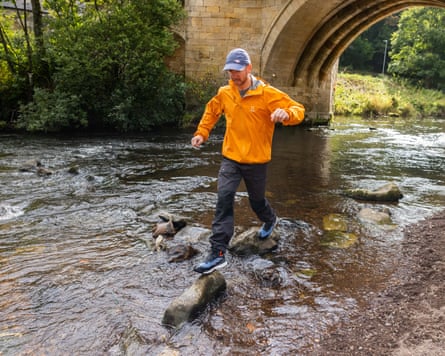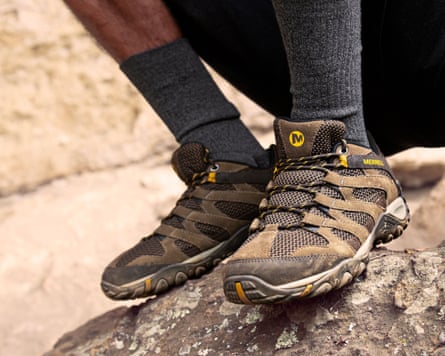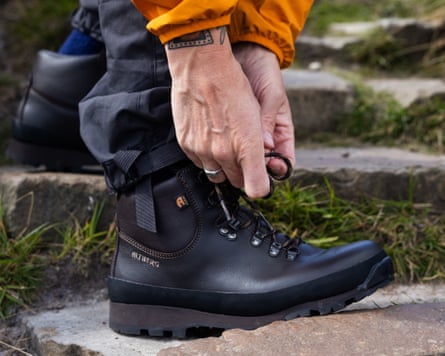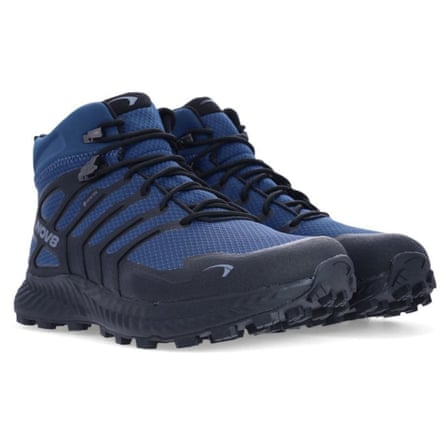There are two types of people on any UK hiking trail: those wearing walking boots, and those who have yet to experience the unmistakable sensation of cowpat seeping through their trainers. I belong in the first camp and firmly believe that the great outdoors is best enjoyed in appropriate footwear.
A solid pair of walking boots will not only protect your feet from countryside unpleasantness but also save you from rolled ankles and skidding on slippery surfaces. Plus, provided they’re waterproof (and not just water-resistant, more on this later), they will keep your feet dry in inclement weather.
At a glance
-
Best walking boots overall:
La Sportiva TX5
From £207.34 at Amazon -
Best budget walking boots:
Merrell Moab 3 Mid GTX
£129.99 at Decathlon -
Best leather walking boots:
Altberg Malham
£234.99 at Altberg -
Best lightweight walking boots:
Inov8 Roclite Mid GTX
£134.99 at SportsShoes -
Best mountain-ready boots:
Mammut Kento Tour High GTX
£220 at Mammut -
Best hiking boots for durability:
Meindl Bhutan MFS
£232 at Cotswold Outdoor
Why you should trust me
I’m a seasoned tester of outdoor gear, trialling everything from running shoes to waterproof jackets. I’ve covered thousands of miles in hundreds of boots, and I know what makes a good pair. My formative years were spent being shoved into hiking boots and dragged up hills by outdoorsy parents. Now an outdoorsy parent myself, I’ve voluntarily remained in hiking boots ever since.
How I tested

There’s only one way to test a pair of hiking boots, and that’s to pop them on, lace them up and hit the trails. So that’s exactly what I did.
First, I whittled it down to a shortlist of 23 styles, which included some I’d already worn extensively and loved. The rest were selected based on a combination of research and recommendations from industry friends and colleagues. I trawled product-comparison tables, waded through stats and agonised over features to find the boots worth considering.
I then put each of the 23 pairs to the test. Living in Northumberland, I’m fortunate enough to have access to extremely varied terrain. Deserted sandy beaches, sprawling pine forests and rolling hills are all within close reach. I also travel a lot, so I’ve put pairs through their paces in the French Alps, the Lake District and even as far afield as New Zealand. I wore each pair for no less than 20 miles. In some cases, many more.
I took the boots into the notoriously boggy Cheviot Hills to test their waterproofness the Northumbrian way (spoiler: not all of them were).
I’d also like to note that boots sourced for this article are being donated to Shoe Aid, a charity that provides free footwear to disadvantaged men, women and children in the UK and Europe.
Here’s my guide to the best walking boots out there.
The best men’s hiking boots in 2025

Best walking boots overall:
La Sportiva TX5

From £180.56 at Alpinetrek
From £207.34 at Amazon
The TX5s are for anyone who wants a durable, comfortable and aesthetically pleasing pair of boots that can handle anything from light hikes to multi-day treks. La Sportiva is an Italian brand that specialises in serious alpine footwear for climbers and mountaineers. The TX5 is an approach boot, meaning it’s designed to bridge the gap between light trails on low ground and extreme high-mountain terrain. That makes this pair perfect for hiking and hillwalking.
Why we love it
I’m on my third pair of TX5s. That’s not to say they’re not durable – quite the opposite. It’s more a reflection of how often I wear them. Of all the boots I’ve tried over the years, these have become my go-to, thanks to their all-day comfort, excellent mixed-terrain performance and tough-as-nails build quality.
The nubuck upper is flexible, breathable and hard-wearing, and the strategically placed mesh sections aid flexibility. This is a seriously comfortable boot, even if it isn’t the lightest, weighing in at 540g for one of my size 9s. This is heavy enough to offer stability, but light enough to remain comfortable over long distances.
One of my favourite details is the chunky rand, a thick rubber strap that runs around the outside of the boot, just above the midsole. It’s fantastic at deflecting bumps, scuffs and scrapes on rocky trails, and it bolsters the Gore-Tex membrane to add an extra layer of defence against water where it’s needed most. After several years in these boots, I haven’t had wet feet once –not even while standing ankle-deep in a peat bog.
It’s a shame that … they run a little narrow, so may not suit wider feet.
Suitable for: day hikes on varied terrain
Material: nubuck
Waterproof: yes, Gore-Tex
Sizing: I needed a half size bigger
Best budget walking boots:
Merrell Moab 3 Mid GTX

£129.99 at Decathlon
£150 at Merrell
I’d recommend the Moab 3s to anyone looking for a comfortable, versatile hiking boot that won’t completely drain their bank account. It can often be found reduced for less than the £150 recommended retail price – and even at that price, you’re getting a lot of boot for your money.
The “mother of all boots” line was first conceived in the mid-00s as a sort of one-stop shop for outdoorsy folk who needed something they could walk, hike and even run in. This latest version of the Moab improves upon the bestselling formula with upgraded ventilation, lower weight (480g for one of my 8.5s) and a nice roomy toe box that’s perfect for wide-footed walkers.
Why we love it
No one could ever accuse the Moab of putting style over substance. This is not, bless it, a particularly trendy boot. But what it lacks in streamlined looks, it more than compensates for with its out-of-the-box comfort and versatility. Whether you’re strolling along coastal cliffs, bagging Wainwrights in the Lake District or traipsing around a field with the dog, this is the perfect boot for the job. If you were to own only one piece of footwear, the Moab would be a strong candidate.
The upper of the boot is an evenly balanced mix of mesh and pig-suede leather with a Gore-Tex membrane sitting beneath. This makes it extremely flexible and highly breathable. As a result, I’d say it’s well suited to warmer-weather adventures. The Vibram sole is supportive and grippy even on slippery surfaces such as tide-pool rocks, and the reinforced panel around the toe offers protection on technical terrain.
The Moab 3 is also completely waterproof thanks to the Gore-Tex membrane, which held up impressively, even in boggy Northumberland.
The biggest selling point for me is the price. It’s not the cheapest boot on the market, but it does offer some of the best value for money.
It’s a shame that … they look a little clunky.
Suitable for: a bit of everything
Material: synthetic mesh/suede
Waterproof: yes, Gore-Tex
Sizing: true to size
Best leather walking boots:
Altberg Malham

If you’re a traditionalist who scoffs at the mere mention of modern synthetic boots, Altberg’s leathery offerings will be right up your street. This particular boot is designed for day hiking or hillwalking paths and trails, so it’s best for those who don’t intend to venture too far off-piste. That being said, with its robust build and sturdy sole, there aren’t many places below the snowline that the Malham wouldn’t confidently take you. It’s a proper boot for proper British hillwalking, built using knowledge passed down over generations.
Why we love it
Quality, handcrafted and small-batch production are Altberg’s USPs. There’s a personal touch to the entire experience that, along with the high quality of the product, I feel justifies the lofty price tag.
The boots themselves are faultless. Comfortable from day one (a rarity among leather boots), and the sole features a subtle rocker profile that propels me forward in a pleasant rolling motion with every step. Of all the boots I tested, these are the ones that filled me with the most confidence as I stood ankle-deep in a Cheviot Hills peat bog. The mostly seam-free uppers and duck-like ability to shrug off water with ease meant that not a single drop got through. They look beautiful too – simple, uncluttered, brown; the way hiking boots always used to be.
The best thing about leather walking boots is that they get more comfortable the more they’re worn, conforming to the contours of the foot as they soften up. I certainly found this to be the case with the Malham, which, after a few hours of walking, felt practically slipper-esque.
It’s a shame that … those durable leather uppers add a lot of weight, which could be tiring on longer walks.
Suitable for: hillwalking in wet and muddy British conditions
Material: leather
Waterproof: yes, Sympatex
Sizing: true to size
Best lightweight walking boots:
Inov8 Roclite Mid GTX

£134.99 at SportsShoes
£150 at Inov8
If you like your hikes fast and your footwear featherlight, this trail shoe on steroids from Inov8 is a solid option. Born on the outskirts of the Lake District, Inov8 is a brand with well-established roots in fell running and a reputation for creating grippy, go-anywhere footwear. The Roclite Mid GTX is no exception. That being said, those on the hunt for something robust, sturdy and built for steep, rocky terrain may wish to keep scrolling, because a stiff, mountain-ready boot this is not.
Why we love it
Light, flexible, sure-footed in mud, and cut just high enough to offer some support without hampering ankle mobility, the Roclite Mid GTX is ideal for those who like to move fast. It’s extremely grippy, with 6mm lugs that bite hungrily into muddy trails and a Gore-Tex membrane that seals out the worst of the British weather. The boots also have what Inov8 calls its “Powerflow Pro” midsole. Techy jargon aside, this is a lightweight foam that gives the Roclite a cushioned, almost bouncy quality.
Fit wise, I found the Roclite to be wide but short. There’s plenty of room in the forefoot, but I found my usual size of 8.5 to be on the snug side in terms of length. If I were to trial these boots again, I’d probably go up a half size.
As fantastic as the Roclite is, it’s important to note that this is not a mountain boot. If your routes tend to involve anything more technical than light scrambling, this is probably not the boot for you.
It’s a shame that … the sizing is a bit awkward.
Suitable for: fast, light hikes in spring/summer and tackling muddy trails
Material: mesh bonded to a Gore-Tex membrane
Waterproof: yes
Sizing: I needed a half size bigger
Best mountain-ready boots:
Mammut Kento Tour High GTX

Casual hillwalking is all well and good, but if you’re looking for something that can carry you to higher altitudes and cope with moderate mountain conditions, this three-season boot from Mammut is an excellent choice. It’s tall, stiff and crampon compatible – perfect for UK mountain adventures.
Why we love it
The Kento Tour is a boot that means business. The collar sits above the ankle for full support, the nubuck upper is thick and hard-wearing, and the rubber rand bolsters overall durability, fending off scuffs and scrapes with ease. The sole is stiff enough to allow precise movement on rocky terrain, but not to the point that walking on the flat becomes an uncomfortable slog.
For a boot this burly, you might expect some initial discomfort, but I didn’t find this to be the case. The Kento felt great from day one, and I was particularly fond of the asymmetric lacing system that extends down almost to the toe. This makes it easy to dial in the fit, fine-tuning the tension where required and making it easy to relieve pressure points.
If you’re tired of burning through lightweight boots, the Kento is worth the investment. Overkill for low-level summer walks? Probably. But as an option to bridge the gap between a relatively soft-soled walking boot and a full-blown mountaineering boot, it’s hard to fault.
It’s a shame that … it’s simply too much boot for casual hikes and hillwalking.
Suitable for: steep climbs and scrambling in spring, summer and autumn
Material: nubuck leather with rubber rand
Waterproof: yes, Gore-Tex
Sizing: true to size
Best hiking boot for durability:
Meindl Bhutan MFS

£232 at Cotswold Outdoor
£290 at George Fisher
Advancements in materials and footwear construction have left traditional leather boots lagging behind their lightweight, synthetic counterparts. But there’s still something to be said for a tough leather hiking boot – as this bestselling option from Meindl proves. If you value longevity, support and all-weather reliability, sometimes the old ways are the best.
Why we love it
The Bhutan MFS is a direct descendant of the German brand’s legendary Burma Pro. Like its predecessor, it’s a classic leather boot perfectly built for tackling mid-mountain conditions. This makes it a superb all-rounder and ideal for UK hiking and walking. It has a full nubuck leather upper, reinforced with a rubber rand, and there’s a Gore-Tex lining that works with the leather to keep feet bone dry. Unfortunately, that weather resistance comes at the expense of breathability, meaning the Bhutan can feel rather stuffy in warm weather.
That’s not to say the Bhutan is in any way uncomfortable. Quite the opposite. The memory foam padding conformed nicely to my ankles as the miles racked up, but I was surprised at just how good the boots felt right away. The high ankle helps with support on uneven terrain, and I found the lacing system great for tailoring the fit.
Underfoot, things are stiff and structured. This is more than welcome on rocky ground, but might feel a bit too rigid for casual strolls on undemanding country paths. The Vibram Multigrip sole is excellent, though. I found traction to be top notch on everything from mud to wet rocks to scree. In short, it’s well equipped to chew up anything the UK hills can feed it.
At 807g per boot, this is no lightweight boot, but the counter-argument is durability, especially when you consider that the Bhutan is designed to be resoled. Expensive? Yes, but consider it an investment. With the right care, it’ll outlast those modern featherweight alternatives several times over.
It’s a shame that … they’re a bit cumbersome and definitely overbuilt for fast, low-level walks, but that’s not what they’re made for.
Suitable for: mountain hikes, long days on rough ground, all-weather hillwalking
Material: nubuck leather with full rubber rand
Waterproof: yes, Gore-Tex
Sizing: I had to go a half size down from my usual UK 8.5, but I do have very narrow feet. For most people, their normal size should be correct.
The best of the rest

Merrell Moab Speed 2 Mid Gore-Tex

£159.95 at Cotswold Outdoor
£160 at Merrell
Best for: style-conscious hikers, and those who like their boots feather-light
This sportier version of the Moab is the lightest boot I tested, weighing just 404g. It felt comfortable immediately. In fact, the first time I put it on, I went straight for a 15-mile walk with no rubbing or pinching whatsoever. That being said, my feet did get rather hot wearing them on a warm summer’s day. Perhaps they’re better suited for use in cold weather.
after newsletter promotion
The boot features aggressive lugs to the sole, which I found to be great for traction on muddy terrain, and the synthetic uppers are surprisingly effective at shedding water. It held up well in the Cheviot slop, too, with no leaks. But what I like most about this boot is the way it looks. It’s almost like a trainer without sacrificing too much sturdiness. I’m a big fan of the felt overlays on the upper and the pop of green in the midsole, too.
It didn’t make the final cut because … the trainer-like feel lacks the stability required for the most demanding terrain.
Suitable for: day hikes and casual wear; material: synthetic; waterproof: yes, Gore-Tex; sizing: true to size
Quechua MH500

Best for: cash-strapped hikers
Decathlon’s in-house camping brand, Quechua, is known for the impressive bang-to-buck ratio of its products. These boots are a prime example. They’re accessibly priced at £69.99, but they’re also surprisingly durable, sturdy and waterproof. They even remained water-tight in the boggy Cheviot terrain.
Granted, they’re not the most beautifully constructed boots – my test pair has visible glue where the outsole meets the toe, and the tongue is extremely thin – but they’re reasonably comfortable, grippy beyond their modest price tag and yet to let in water. This is about as good as it gets for under £100, unless you want to wait around for the sales.
It didn’t make the final cut because … the build quality isn’t perfect.
Suitable for: light hikes on mixed terrain; material: synthetic; waterproof: yes; sizing: true to size
Keen Arroyo II

From £55 at Keen
From £69.12 at Amazon
Best for: warm summer hikes
Keen’s Arroyo II is not actually a boot at all. Still, it was important to include something for those who find traditional hiking boots too hot in summer. This is essentially a hiking shoe-sandal hybrid, offering a rare combination of complete ventilation and a robust, grippy sole for support and traction on rough terrain. The neoprene lining means the walking shoes are comfortable with or without socks, and bungee laces make them easy to get on and off.
If I had to pick fault, I’d say the Arroyo II is not much of a looker. But, hey, you’re heading to the hills, not Milan fashion week. They also feature a label that confusingly says “waterproof”. I’m no engineer, but there are definitely a few openings where liquid can (and does) enter these shoes.
It didn’t make the final cut because … they take an age to dry out if they get wet.
Suitable for: day hikes in dry, summer conditions; material: leather; waterproof: the waterproof leather is, but the vents mean the overall shoe is anything but; sizing: true to size
Salomon Quest 4 Gore-Tex

Best for: long distances in tough conditions
If you’re after something that’s built like a tank, and offers maximum support, foot protection and comfort over the longest of distances, Salomon’s Quest 4 is the boot for you. It is, in a word, beefy. Every textile panel, piece of leather and rubber overlay is burly and tough, giving an overall sense of robustness – if it can be reinforced, it has been reinforced. It’s also the tallest boot I tested, extending several inches above the ankle, and waterproof all the way to the top. That means it works well when carrying heavy loads, such as on overnight backpacking trips or multi-day expeditions.
If your average jaunt into the wilderness involves mostly light trails, bridleways and rarely creeps over 10 miles, this is not the boot for you. If, on the other hand, you regularly venture off the beaten track and cover long distances in less than favourable conditions, the Quest 4 is the workhorse for which you’ve been looking.
It didn’t make the final cut because … this heavy, stiff boot is overkill for casual hikes.
Suitable for: multi-day treks with a heavy pack; material: leather/synthetic mix; waterproof: yes, Gore-Tex; sizing: true to size
Danner Mountain 600 Evo

Best for: classic looks packed with modern tech
Old meets new in this hybrid boot from American bootmaker Danner. With a round toe, D-ring lacing system and clean full-grain leather upper, it looks like a traditional leather hiking boot at first glance. Look a little closer, though, and you’ll find it’s anything but. A springy foam midsole lends the boot an almost trainer-like quality, and a synthetic textile in the tongue gusset adds a pop of colour while also bringing the weight down. I found them to be completely waterproof in rain and standing water.
I was particularly fond of the lacing system, which extends almost to the toe. This meant I was able to tailor the fit by tightening and loosening certain portions all the way up the boot, resulting in a remarkably comfortable first hike. There’s also a spare pair of flat laces in a different colour included, which is a nice touch.
It didn’t make the final cut because … it lacks a proper toe guard for rocky trails.
Suitable for: day hikes on mixed terrain; material: leather/synthetic mix; waterproof: yes, Gore-Tex; sizing: true to size

£210 at Vivobarefoot
From £173.50 at Amazon
Best for: wide feet or barefoot shoe enthusiasts
Barefoot shoes, also known as zero-drop or minimalist shoes, have been growing in popularity for several years. Vivobarefoot is the brand responsible for starting the craze. Its thin-soled footwear is designed to reconnect the wearer to the earth below them while allowing the foot to move in the way nature intended.
The Tracker Forest Esc brings this concept to the world of hiking. The boot features a wide, roomy front that gives toes room to spread while walking, and the sole is thin enough to allow the terrain to be felt underfoot, despite being heavily treaded with deep rubber lugs. Once I got used to the sensation of having my foot flat on the ground with no cushioning elevating my heel, I found the Tracker Esc to be incredibly comfortable and grippy. My feet had plenty of room to move around inside, but the high collar and wide positioning of the lace loops meant the boots never felt loose or excessively roomy.
I know several avid walkers and hikers with wide feet (including my own mother) who have historically struggled to find shoes that fit. They tell me that switching to barefoot designs has been a gamechanger in terms of comfort. On top of that, Vivobarefoot is a certified B Corporation, which makes me feel slightly better about trampling all over mother nature in its products.
It didn’t make the final cut because … these boots are not fully waterproof. They will let water through in the wettest of conditions, so they may not be the best option for British winters.
Suitable for: hiking and trekking in dry conditions; material: leather; waterproof: no; sizing: runs half a size large
What you need to know

Waterproof vs water resistant
Most hiking boots are treated with a durable water repellent (DWR) coating that allows water to bead off the surface. This makes them water resistant, but it doesn’t necessarily make them waterproof. DWR alone won’t stop water from getting through in heavy rain or when the boot is fully submerged.
Waterproof boots are treated with DWR too, but they also feature a membrane beneath the face fabric that stops water droplets from passing through while still allowing water vapour – ie sweat – to escape from within.
Gore-Tex is the biggest name in waterproof membrane, but there are others, such as Sympatex and Pertex, that work in much the same way.
It’s worth noting that even the very best waterproof boots may not keep your feet bone dry all the time. Sometimes, water can creep in at the ankle and be unable to escape, or your feet will begin to produce sweat faster than the fabric can wick it to the outside. Either way, the result is damp socks.
Fit
Hiking boots are supposed to be worn with thick socks. It’s also likely your feet will swell slightly as you rack up the miles. Your boots should fit slightly larger than your street shoes to accommodate for this. But fear not, most boot brands factor this in. So, in most cases, your normal size should be correct.
If in doubt, many brands have online sizing tools and charts you can consult. Or, in an ideal world, go into your local outdoors shop to try on a few pairs. As a wise shop assistant once told me: “The pair of boots you want isn’t necessarily the pair of boots you need.”
Another option is to go for a scan. This is the most accurate way of measuring your feet, and it can be particularly useful for those who struggle to find footwear that fits. Many outdoor shops offer this service in store, Cotswold Outdoor being one of them.
Another thing to consider is weight. Lighter boots tend to be more comfortable and manoeuvrable. Heavier boots often provide greater stability, but can tire out the legs over long distances.
Material
Leather boots are famously hardy, but they’re also heavy, cumbersome and can lack breathability. As a result, brands are increasingly working with synthetic materials that allow them to make their boots lighter and more breathable. Unfortunately, this tends to come at the expense of durability.
If you’re looking for a lightweight boot that’s highly breathable and immediately comfortable but may last only a year or two, go for synthetic. If you want a solid workhorse of a boot that’s perhaps a little heavy, but will still be chugging away after multiple resoles, choose leather.
A good compromise is nubuck. This low-maintenance buffed leather is more flexible and breathable than its full-grain counterpart, with better durability than many synthetic materials. This makes it a popular choice for hiking boots.
Care and cleaning
Maintenance is extremely important if you want to preserve the life and waterproofness of your boots. Most brands offer detailed instructions, but generally speaking, you’ll need to do the following regularly.
-
Clean: scrub away excess mud and wipe boots with a damp cloth.
-
Dry: remove moisture from inside the boots by stuffing them with newspaper and leaving them to dry out.
-
Reproof: that DWR coating needs to be refreshed at regular intervals. The material of your boots will determine the best product for the job, so check the manufacturer’s website for recommendations.
Price
Just like energy, food and housing, hiking boots aren’t getting any cheaper. These days, it’s difficult to find a durable, comfortable pair for less than £100 without hitting the sales. Most mid-range pairs sit somewhere between £150 and £220, and high-end mountaineering boots can easily hit £500+.
The mid-range tends to be the most cost-effective place to aim. Cheap out on low-quality boots, and you risk having to replace them sooner than anticipated. As for the high-end stuff – if your typical outdoor adventure tends not to involve ropes, helmets or belay devices, they’re almost certainly overkill.
How to break in walking boots
If your new boots are giving you trouble, you might be wondering how to break them in. Well, good news and bad news. According to Peter, a boot fitter at LD Mountain Centre in Newcastle upon Tyne, most boots should be pretty comfortable straight out of the box. If yours aren’t, it could point to a problem with the fit. The good news is that it may just be a case of wearing them on shorter walks at first and gradually building the distance. Failing that, the shop you bought them from might be able to help.
“Most modern synthetic boots shouldn’t really need breaking in, but if your leather boots are nipping somewhere, the shop you bought them from can use a rubbing bar [a boot-fitting tool for reshaping leather footwear] to stretch the problem area out slightly,” Peter says. “Chances are, these things sort themselves out over time anyway, but using the rubbing bar can speed up the break-in process.”
In Peter’s view, prevention is better than cure, which is why trying on boots is such an important part of the process. “I always give the customer at least three boots to try after assessing their foot shape and volume,” he says. “We then pick the best fit out of those.”
He also points out that most good boot shops will give you the option to wear your boots around the house for a few weeks and return them if they’re not quite right.
For more footwear inspiration, read our guide on the best boots for men
Paddy Maddison is a consumer journalist, outerwear enthusiast and exercise addict. If he’s not hiking in the hills, he’s grinding up them on his bike, hurtling down them on his snowboard, or lacing up his running shoes and hitting the pavements. As a result, he gets plenty of time to put all the latest and greatest gear through the wringer for the Filter
This article was originally published on 10 October 2024. Reviews published in the Filter may be periodically updated to reflect new products and at the editor’s discretion. The date of an article’s most recent update can be found in the timestamp at the top of the page. This article was last updated on 15 May 2025; prices and retailers were updated, more hiking boots were reviewed and included and advice on breaking in boots was added.

 7 hours ago
6
7 hours ago
6

















































